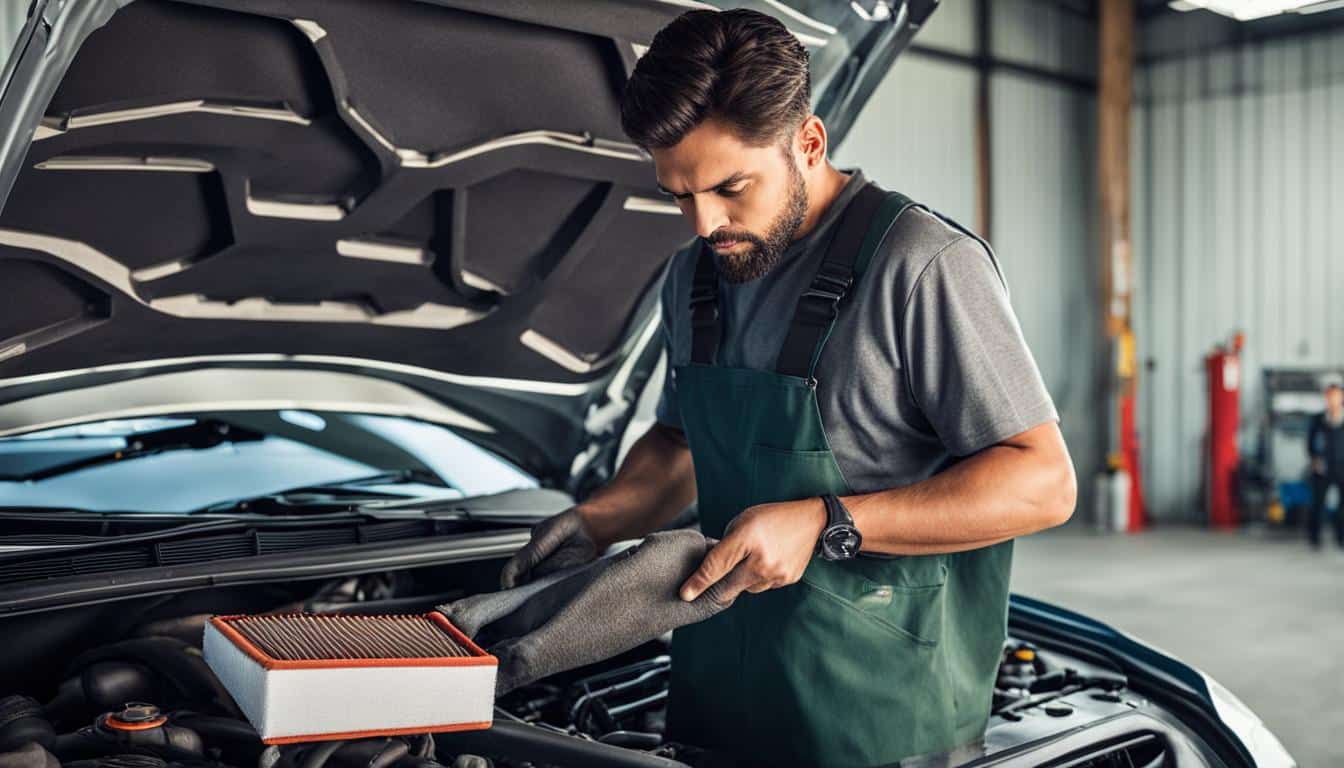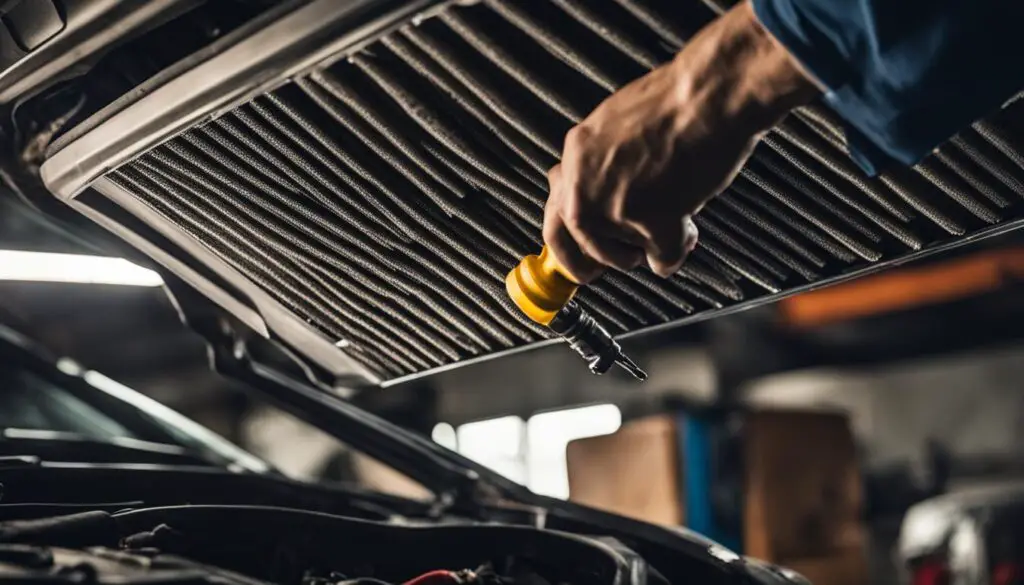
Understanding and Replacing Car Filters
As a car owner, you want to ensure that your vehicle runs smoothly and efficiently for as long as possible. Regular maintenance is a crucial aspect of achieving this goal, and car filter replacement should not be overlooked. Car filters play a critical role in preserving engine health, improving fuel economy, and providing a comfortable driving experience.
There are various types of car filters, including air filters, oil filters, and cabin filters. Each filter serves a unique purpose and needs to be replaced regularly to maintain optimal performance. Knowing the basics of car filter replacement is essential for every car owner, and in this section, I will guide you through everything you need to know.
Key Takeaways:
- Regular car filter replacement is necessary for a smooth and efficient drive.
- Air filters, oil filters, and cabin filters are essential types of car filters.
- Understanding car filter replacement is crucial for every car owner to maintain vehicle performance.
- DIY car filter replacement is possible and cost-effective.
- Following the recommended maintenance schedule for filter replacements is crucial.
Step-by-Step Car Filter Replacement Guide
Replacing car filters is an important part of vehicle maintenance that can save you money and ensure optimal performance. In this section, I will guide you through the process of replacing car filters in a step-by-step manner, including air filters, oil filters, and cabin filters.
Air Filter Replacement
The air filter is responsible for preventing dirt, debris, and other contaminants from entering the engine. A dirty air filter can reduce engine performance and fuel efficiency. Here’s how to replace your car’s air filter:
- Locate the air filter housing, which is typically a black rectangular box with clips holding it closed.
- Open the housing and remove the old air filter.
- Check the new air filter for fit and make sure it matches with the old one.
- Insert the new air filter into the housing, making sure it is properly seated.
- Close the clip or housing and start the engine to ensure proper installation.
Remember to follow your car manufacturer’s recommended maintenance schedule for air filter replacement.
Oil Filter Replacement
The oil filter removes contaminants from the oil before it circulates through the engine. A dirty oil filter can cause engine damage and reduce performance. Here’s how to replace your car’s oil filter:
- Locate the oil filter, which is typically a cylindrical shape and located near the engine block.
- Using an oil filter wrench, loosen the old oil filter in a counterclockwise motion.
- Remove the old oil filter and use a clean cloth to wipe the filter mounting surface.
- Apply a thin layer of oil to the rubber gasket of the new oil filter.
- Install the new oil filter by turning it in a clockwise motion until it is tight.
- Refill the engine with the recommended amount of oil and start the engine to ensure proper installation.
Remember to dispose of the old oil filter properly and follow your car manufacturer’s recommended maintenance schedule for oil filter replacement.
Cabin Filter Replacement
The cabin filter removes dust, pollen, and other irritants from the air inside the car. A dirty cabin filter can reduce air flow and cause unpleasant odors. Here’s how to replace your car’s cabin filter:
- Locate the cabin filter, which is typically behind the glove box or under the dashboard.
- Remove the glove box or dashboard panel to gain access to the cabin filter housing.
- Open the housing and remove the old cabin filter.
- Check the new cabin filter for fit and make sure it matches with the old one.
- Insert the new cabin filter into the housing, making sure it is properly seated.
- Close the housing and reattach the glove box or dashboard panel.
Remember to follow your car manufacturer’s recommended maintenance schedule for cabin filter replacement to ensure a clean and comfortable driving environment.

Following these steps for each type of car filter replacement can help you maintain the health and efficiency of your vehicle. Remember to always refer to your car’s owner’s manual for specific instructions and recommended maintenance schedules. By following best practices for car filter replacement, you can save money and ensure a smooth driving experience.
Conclusion
As we have seen, regularly replacing car filters is crucial for maintaining optimal vehicle performance. By following the step-by-step guide provided in this car filter replacement guide, you can confidently replace air filters, oil filters, and cabin filters on your own, saving time and money.
Remember, keeping up with your car’s recommended maintenance schedule is key to preventing costly repairs down the line. By replacing filters, you can improve fuel efficiency and ensure a clean and comfortable driving environment.
Thank you for taking the time to read this guide on car filter replacement. With the knowledge and skills gained from this guide, you can take an active role in maintaining your vehicle’s health and longevity. If you have any questions or concerns, feel free to refer back to this guide or consult with a professional mechanic.
FAQ
Why is it important to replace car filters regularly?
Regularly replacing car filters is important to maintain a smooth and efficient drive. Filters, such as air filters, oil filters, and cabin filters, play a crucial role in keeping your car’s engine clean, improving fuel efficiency, and providing a clean and comfortable driving environment.
How often should I replace my car filters?
The frequency of car filter replacements can vary depending on the manufacturer’s recommendations and driving conditions. As a general guideline, it is recommended to replace the engine air filter every 12,000 to 15,000 miles, the oil filter during every oil change, and the cabin air filter every 15,000 to 20,000 miles or as needed.
Can I replace car filters myself or should I take it to a professional?
Car filter replacements can often be done by yourself, especially with the help of a step-by-step guide. However, if you are unsure or uncomfortable with the process, it is always advisable to consult a professional mechanic who can perform the replacements accurately and efficiently.
What are some signs that indicate I need to replace my car filters?
Some common signs that indicate the need for car filter replacements include reduced airflow, decreased engine performance, increased fuel consumption, unpleasant odors in the cabin, and visible dirt or debris on the filters. If you notice any of these signs, it is recommended to have your filters inspected and replaced if necessary.
Where can I purchase replacement filters for my car?
Replacement filters for your car can be purchased from various automotive retailers, online stores, or authorized dealerships. It is important to ensure that you purchase the correct filters that are compatible with your car’s make and model for optimal performance.
Are there any specific tools or equipment required for car filter replacements?
The tools and equipment required for car filter replacements can vary depending on the type of filter being replaced. However, some common tools that may be needed include screwdrivers, pliers, a socket wrench set, and a filter removal tool. It is recommended to refer to the specific instructions in your car’s manual or the replacement filter’s packaging for accurate information regarding the tools required.
